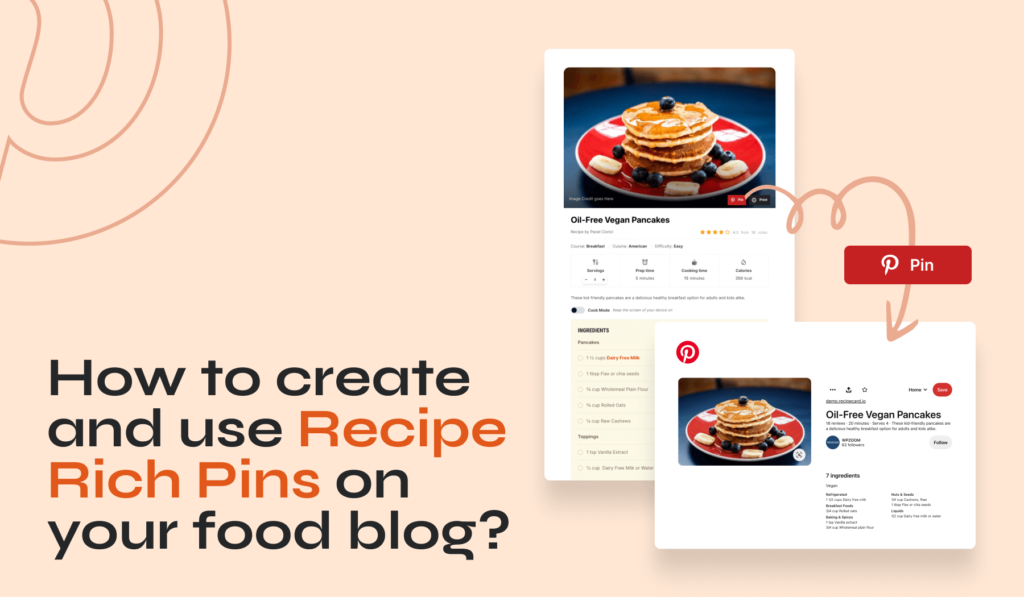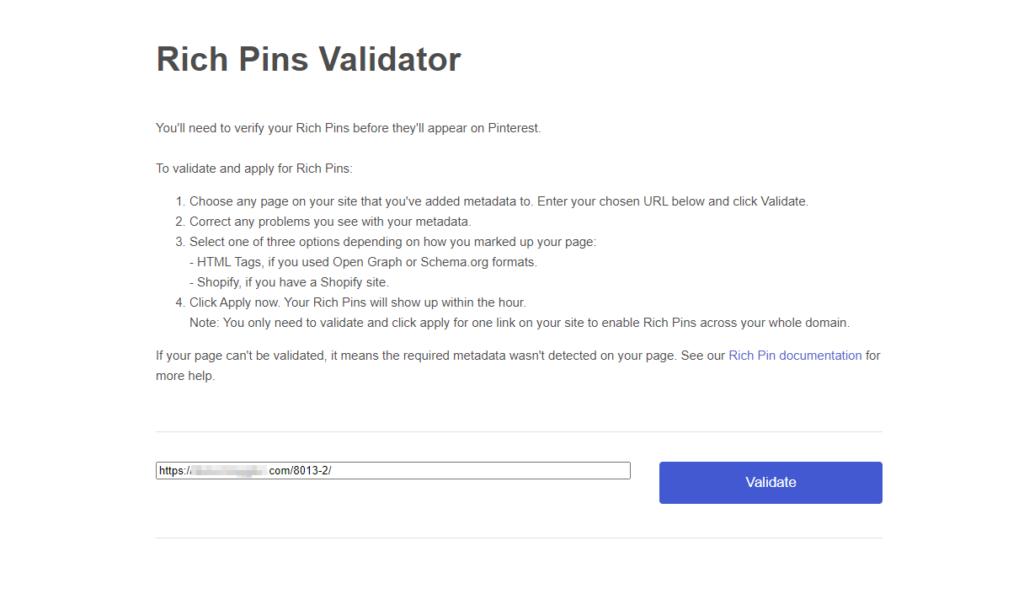
Looking for a way to boost engagement on your food blog? Use Recipe Rich Pins.
Many people use Pinterest nowadays to find recipes and full meal prep techniques rather than flipping through a hefty cookbook. This is because the platform makes it easy for users to view ingredients and recipes in a visually attractive post-style format rather than reading them in plain text form from your food blog or from a cookbook.
However, you will need a way to create Recipe Rich Pins on your food blog to present your recipes in a visually-appealing and engaging way.
In this post, we’ll explain how you can create and use Recipe Rich Pins on your food blog.
What are Pinterest Rich Pins?
Pinterest uses “Pins” as posts that users can create and publish on their websites. Rich Pins are essentially the premium or more detailed versions of standard Pins, and they let users add extra metadata to each post.

As a result, it creates enhanced Pins that can help boost engagement and ensure a better user experience.
Pinterest lets you create three different types of Rich Pins that are suited for most business types. Here’s a quick breakdown of each one and the metadata it includes:
- Article Rich Pins. Article Rich Pins are primarily used for showcasing blog posts in a better way. These types of Rich Pins showcase the title, meta description, publish date of the post, and in some cases, the author of the post.
- Recipe Rich Pins. Recipe Rich Pins are every food blogger’s bread and butter. They’re designed to help users showcase recipes published on Pinterest in a way that’s easily digestible by your audience. You can showcase the recipe’s title, rating, ingredients, and serving size. However, this depends on the recipe card tool or plugin you use.
- Product Rich Pins. Product Rich Pins are designed to showcase a product’s real price, stock level, and a call to action button for users to quickly purchase the product using the Rich Pin.
What are the advantages of Recipe Rich Pins?
While there are other types of Rich Pins Pinterest lets you create, Recipe Rich Pins are the most useful for food bloggers.
To better understand this, let’s go over some of the major advantages of using Recipe Rich Pins on your food blog:
#1: More information
Compared to using standard Pins to showcase your top recipes, it’s much better to use Recipe Rich Pins as they are designed specifically for this purpose. This not only makes your recipes look more professional but is great for showcasing more information in your Pins.
The information you’re able to show for each recipe typically includes the recipe’s title, star rating, ingredients, and serving size.
#2: Boost traffic
Since Recipe Rich Pins make it easier for your audience to view recipes and go through them in a visually attractive post-style layout that can potentially bring more traffic to your food blog.
This is because you can gain a lot of attention for your brand by publishing visually-appealing Recipe Rich Pins and then using the newly gained attention to drive traffic to your food blog. For instance, you can encourage users to check out your food blog if they’re interested in viewing more recipes like this.
#3: Enhance SEO
Recipe Rich Pins include more metadata than ordinary Pins which not only helps boost engagement on your posts but makes your recipe cards more search engine friendly.
In addition to this, you can enhance the SEO of your food blog and make your recipes easier to search.
#4: Improve branding
The best part is that even though you’re using Pinterest Pins, the platform lets you create your brand’s “Business” account and upload a profile picture or logo. This ensures everything looks according to your brand’s aesthetics and makes it easier to improve your branding.
#5: Easy customization
If you want to make changes to the information in your recipes, you don’t have to worry about creating a new Recipe Rich Pin.
This is because all information is updated automatically if you make any changes to your recipes. This eliminates the need to create new Pins every time you want to make modifications to your recipes.
What do you need to enable and create Recipe Rich Pins?
To enable and create Recipe Rich Pins on your food blog, you will need a Pinterest Business account. This is because Rich Pins only work with business accounts and require you to validate your website. For more information on this, you can go over the official guide from Pinterest.
The easiest way to create recipes on your food blog so they’re validated as Recipe Rich Pins is by using a recipe card plugin such as Recipe Card Blocks.

The plugin offers an all-in-one solution for creating Recipe Rich Pins directly from your WordPress food blog. It lets you create highly professional, attractive-looking recipes that include all the information required by Pinterest to classify them as “Rich Pins”.
How to create Recipe Rich Pins for your food blog
Here, we’ll show you how you can create and use Recipe Rich Pins on your food blog using the Recipe Card Blocks plugin.
For this, you will need a Pinterest account, a WordPress site, and the Recipe Card Blocks plugin.
Step #1: Convert your Pinterest account to a Business account
To get started, log in to your Pinterest account and click on the Convert to Business button by clicking on your profile icon from the top-right of your screen.

Click on the Upgrade button to successfully convert your Pinterest account to business.

Complete all the steps required for setting up basic details about your brand like adding your logo, name, and website. Complete all the steps to continue.
Step #2: Install the Recipe Card Blocks plugin
Recipe Rich Pins work with both the free and premium versions of Recipe Card Blocks.
You will need to download and install the Recipe Card Blocks plugin on your WordPress site. To do this, navigate to Plugins → Add New and upload the plugin’s ZIP file to the meta box.
Click on the Install Now button and make sure to activate the plugin once it’s installed. Now navigate to Recipe Cards → Settings from the WordPress admin panel and paste the license key given to you at the time of purchase in the Activate Your License Key section. Click on the Save License button to continue.
The free version of the plugin can be easily installed directly in the WordPress Dashboard in Plugins → Add New. Simply search for “Recipe Card Blocks” in the repository and then install and activate the plugin.
Step #3: Create recipes
Creating recipes with the Recipe Card Blocks is very straightforward. Navigate to Recipe Cards → All Recipes and click on the Add New button to begin.

Enter all information related to your recipes such as the title, ingredients, the steps required to create the recipe, and the equipment needed for it.
You can also add more information in the Notes section. This is great for mentioning information that doesn’t fit into other categories such as ingredient substitutes or alternative food preparation techniques. Once you’re ready, click on the Publish button to continue.
Now that you have a recipe created, copy its shortcode using the Recipe Card Post Details dropdown menu.

You can now publish the shortcode on any page or post of your WordPress site using the Shortcode block.

Step #4: Validate your website on Pinterest
Finally, navigate to the Pinterest Rich Pins Validator page and paste the URL of the page that has the recipe shortcode in it.

Click on the Validate button to let it automatically scan your webpage for Recipe Rich Pins.

You only have to validate one recipe for Recipe Rich Pins and the other recipes from your food blog will become automatically rich pins-compatible.
Bonus features
That’s not all, the Recipe Card Blocks plugin also lets you showcase a Pinterest button on your recipes.

This is great for diverting traffic from your blog post to your Pinterest account. In addition to this, you can also include a call to action in your site’s footer.

This way, your audience can easily navigate to your Pinterest profile directly from your WordPress site.
Conclusion
Creating and using Recipe Rich Pins on your food blog is a great way to boost engagement and enhance the SEO of your recipes. As a result, you’re more likely to receive more traffic and make your recipes searchable.
The easiest way to do this on your food blog is by using a recipe card plugin such as Recipe Card Blocks. The robust plugin comes with all the functionality you need to create detailed recipes that can be showcased as Recipe Rich Pins on Pinterest without you having to put in any extra effort.
Ready to start adding Recipe Rich Pins to your food blog? Get Recipe Card Blocks Pro today!